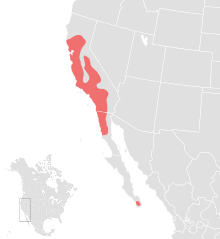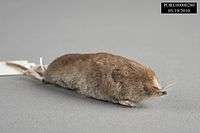Ornate shrew
| Ornate shrew | |
|---|---|
 | |
| Sorex ornatus relictus | |
| Scientific classification | |
| Kingdom: | Animalia |
| Phylum: | Chordata |
| Class: | Mammalia |
| Order: | Eulipotyphla |
| Family: | Soricidae |
| Genus: | Sorex |
| Species: | S. ornatus |
| Binomial name | |
| Sorex ornatus Merriam, 1895 | |
 | |
| Ornate shrew range | |
The ornate shrew (Sorex ornatus), is a species of mammal in the family Soricidae (shrews).[2] It is endemic to western North America, ranging from Northern California in the United States to Baja California in Mexico.[1] Eight subspecies are known, including the extinct tule shrew (S. o. juncensis), known only from four specimens collected in 1905, and the Suisun ornate shrew (S. o. sinuosus), a species of conservation concern in California.
Description

.jpg)
Ornate shrews are small shrews. They weigh on average 5.12 g (0.181 oz). The total length of the animal averages 99.4 mm (3.91 in) with a hindfoot measuring 12.1 mm (0.48 in). The tail is relatively short, measuring 37.5 mm (1.48 in).[3] The shrew molts, with a change in fur coloring at different times of year. The coat is overall drab, brown on the back, trending towards a gray or buff on the underside. In winter, the backside coloring is darker brown, while the underside tends towards a grayish-white. Subspecies towards the south tend to be larger in size, and with darker markings, than those in the north.[4]
The skull measures on average 16.3 mm (0.64 in) in length. The palate averages 6.82 mm (0.269 in) in length and the distance between the eye-sockets averages 3.31 mm (0.130 in). The cranium is around 4.59 mm (0.181 in) long and 7.96 mm (0.313 in) wide.[5] The overall shape of the skull is rather flat and broad, with a depression between the eye-sockets.[4]
The tail of the shrew is bicolored, gradually ranging from brown above to more gray underneath.[4]
Taxonomy
Subspecies
ITIS lists the following subspecies:[6]
- Sorex ornatus juncensis Nelson and Goldman, 1909
- Sorex ornatus lagunae Nelson and Goldman, 1909
- Sorex ornatus ornatus Merriam, 1895
- Sorex ornatus relictus Grinnell, 1932 – Buena Vista Lake ornate shrew, Buena Vista Lake shrew
- Sorex ornatus salarius von Bloeker, 1939 – Monterey ornate shrew
- Sorex ornatus salicornicus von Bloeker, 1932 – salt marsh ornate shrew
- Sorex ornatus sinuosus Grinnell, 1913 – Suisun ornate shrew
- Sorex ornatus willetti von Bloeker, 1942 – Santa Catalina ornate shrew
Distribution and habitat
The ornate shrew is found along portions of the west coast of North America and a few near shore islands. The northern extent is around 39 degrees latitude in California. The range extends south into the Baja Peninsula. There is a stretch of territory through Baja where the shrew is not found, then it is found again near the southern tip. Santa Catalina Island hosts a population of a subspecies of ornate shrew (S. o. willetti). There are reports of ornate shrews on the islands of Santa Cruz and Santa Rosa as well.[4]
Ornate shrews reside among coastal marshes and palustrine environments. Certain subspecies may be found only within specific habitats. The shrews have been found at altitudes as high as 2,400 metres (7,900 ft) in the San Jacinto Mountains.[4] Ornate shrews were once common and widespread throughout their geographic range. However, populations in sensitive ecological regions have dwindled sharply. These areas include coastal wetlands, salt marshes, and freshwater swamps. Ornate shrews are also less common or have been eliminated from areas of intensive agriculture in central California.[1]
Behavior and ecology
The breeding period of the ornate shrew starts in late February and ends in late September or October.[7] Shrews of similar size have a gestation period around 21 days, but no definitive information on the ornate shrew is available.[7]
Human interactions
Conservation status
The International Union for Conservation of Nature and Natural Resources (IUCN) lists the conservation status of the ornate shrew as "Least Concern". The rationale cited is the broad geographic range of distribution and a population stable enough that listing the animal as threatened would not be appropriate. However, they note that geographically restricted groups on the Baja Peninsula may be vulnerable due to habitat loss from human activity and other environmental stresses. The tule shrew, a subspecies of the ornate shrew, is recently extinct. The Government of Mexico has enacted special legal protections for ornate shrews. There are protected areas in both Mexico and the United States where ornate shrews are found.[1]
Further reading
- Owen, James G.; Hoffmann, Robert S. (15 December 1983). "Sorex ornatus" (PDF). Mammalian Species. 212: 1–5. doi:10.2307/3504070. Retrieved 27 November 2014.
References
- 1 2 3 4 Ticul Alvarez, S.; Matson, J.; Castro-Arellano, I.; Woodman, N.; de Grammont, P.C. & Hammerson, G. (2008). "Sorex ornatus". IUCN Red List of Threatened Species. Version 2009.2. International Union for Conservation of Nature. Retrieved 8 February 2010.
- ↑ Hutterer, R. (2005). "Order Soricomorpha". In Wilson, D.E.; Reeder, D.M. Mammal Species of the World: A Taxonomic and Geographic Reference (3rd ed.). Johns Hopkins University Press. p. 294. ISBN 978-0-8018-8221-0. OCLC 62265494.
- ↑ Owen & Hoffmann 1983, p. 1.
- 1 2 3 4 5 Owen & Hoffmann 1983, p. 2.
- ↑ Owen & Hoffmann 1983, pp. 1–2.
- ↑ "Sorex ornatus". Integrated Taxonomic Information System. Retrieved 11 January 2015.
- 1 2 Owen & Hoffmann 1983, p. 3.
